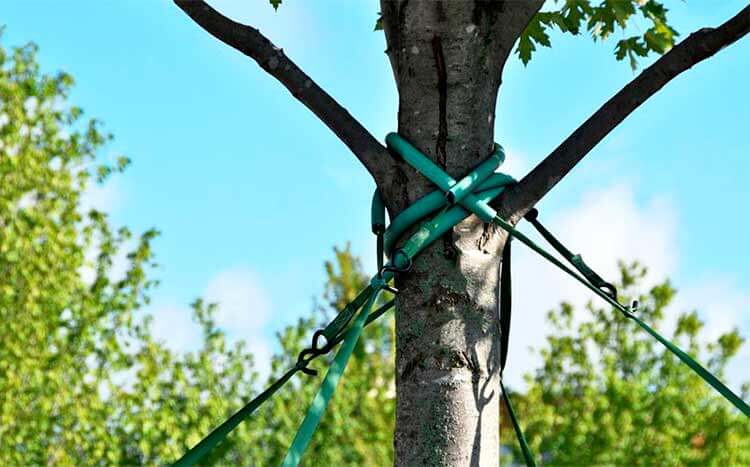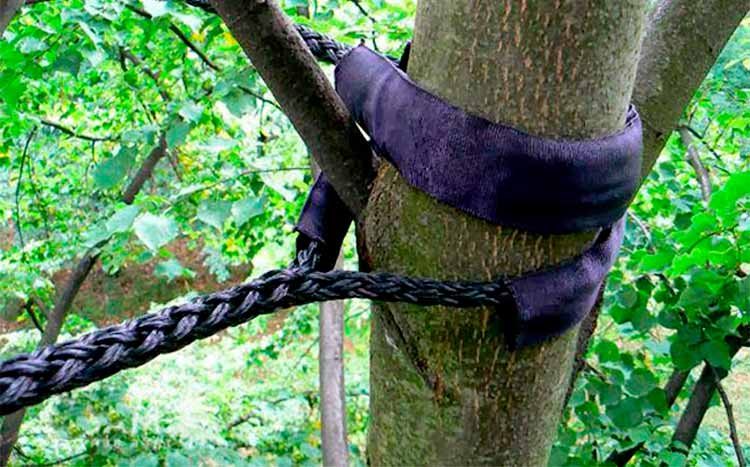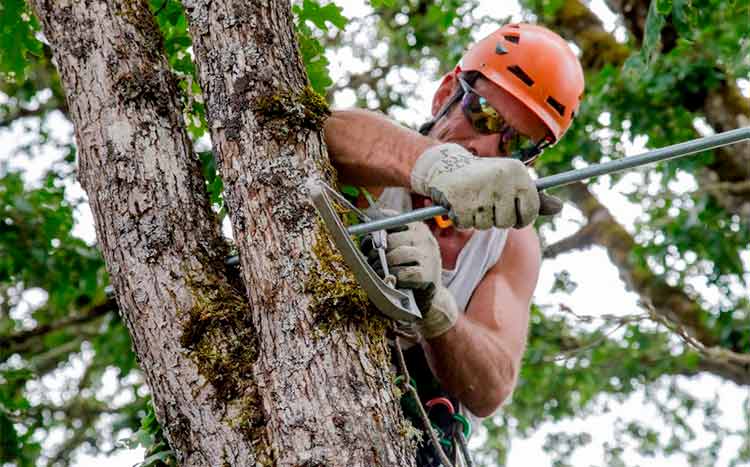A tree’s base is essential to a tree’s survival because it contains critical parts of a tree’s transportation system. All the nutrients and water that the tree needs in order to survive and thrive have to pass through it. Therefore, any rotting that happens in this area is an understandable cause of concern. This is so especially when you consider that rotting is a sign of a dying or dead tree.
In most cases, if you have a tree that is rotting at its base, the best thing that you can do is nothing — as far as treating or sealing the rotting area is concerned. This is because trees are usually adept at sealing off wounds and when they are given a chance, they can effectively seal off the rotting area, develop a new bark, and resume their healthy growth trajectory. During this period, all that the tree will need is a healthy amount of water and nutrients. Therefore, watering and fertilizing it are great ways of boosting its chances of overcoming a rot-in-base problem.
Here is what you should know about tree rotting and what you can do to save your tree.

Reasons for Tree Cabling
Tree cabling is done for various reasons depending on the state of the tree, size, needs, and other considerations as determined by a skilled arborist or skilled tree maintenance professional.
Here are some of the main reasons why you would require tree cabling services:
1. For Crown Aesthetics
One of the most common reasons for mature tree cabling is to guide the growth of major tree branches. This is mostly done on trees growing in residential areas where curb appeal is important and trees need to grow in a certain way. For instance, a tree can be tied in a specific way so that its crown can develop a desirable crown shape for beauty.
Sometimes cabling is also done to correct lopsided major branch or limb to preserve its appearance. For instance, if a branch was physically damaged and appears crooked, cabling will correct it and ensure it adopts the correct shape or grows in a certain direction.
You can contact an arborist to assess the state of your tree and see if it is possible to correct its appearance. Sometimes tree limbs are too old or too advanced in their development that cabling them would not work.

2. To Restore Health After Damage (Protection)
If a section of a tree was damaged in a storm or any other means, it may affect the stability and overall health of the tree. Open wounds on the trunk or damaged limbs will affect the structural integrity of the tree. They may also invite harmful parasites such as termites that cause a lot of damage to the inner sections of a tree.
Professional tree experts or arborists can cable damaged sections of a tree to promote healing and prevent pests or diseases. They usually cable the damaged limbs or trunks in a specific way so that they can be reattached to the tree and heal. Special skills are required to restore storm-damaged limbs through cabling.
Cabling For Safety (Prevention)
Tree cabling can also be done for safety purposes in normal weather conditions, or before and after rough weather such as cyclones. Large tree limbs, branches, or leaning trunks can be cabled in a certain way to prevent them from falling on nearby structures or people. For instance, if you have a major branch that is hanging over a sidewalk or garage, it can be tied to the trunk to prevent injuries.
Safety cabling is one of the common reasons for this activity. It is advisable to have your tree cabled as part of your storm-proofing routine. This will minimize or prevent damage to buildings and other important possessions as weak branches tend to become dangerous projectiles due to gusty winds.
3. To Restrict Growth
Cabling is one of the main methods used to restrict a tree’s height and crown density for various reasons. The Japanese have used cabling for many years to develop the traditional Bonsai trees. Through cabling at a young age, a tree can be made to maintain a certain height and shape for many years and still develop normally.
Cabling to restrict tree height and crown density is a complex task that requires years of training and knowledge of trees. You will need a professional to cable your young trees otherwise you may end up with a lot of dead or dry young trees through improper cabling.
4. To Support Weak Trees
Some trees have naturally weak trunks and limbs and usually need to be cabled or braced at a certain age for support. Cabling is required to keep these trees healthy up to a certain age before they can support themselves. If you notice that your yard trees have weak trunks or leaning, having them cabled or braced might help.

Cost Of Tree Cabling
Tree cabling is done by professional tree maintenance services or trained arborists who charge an hourly or flat rate for their services. The average flat rate for tree cabling in most places ranges between $200 to $500 depending on the size of the tree and other factors.
The table below outlines costs for tree cabling services based on various factors. These are rough estimates to guide you when negotiating rates with a tree cabling service.
| Tree cabling | Low Price | High Price |
|---|---|---|
| Small trees | $150 | $200 |
| Medium Sized trees | $200 | $350 |
| Large Trees | $350 | $500 |
| X-large Trees | $700 | $1000 |
| Preventive cabling (storm proofing) | $200 | $800 |
| Cabling cost per square foot | $10 | $20 |
| National Average | $200 | $500 |
The following factors will influence how much you will be charged for tree cabling services.
- Size of the tree or limbs– This is the most important factor used to quote tree cabling services. Generally, small young trees will be cheaper to cable while large mature trees attract higher rates.
- Crew members needed– How many certified professionals will be needed to do the cabling? The more people you require, the higher costs since most of them are paid on an hourly basis. Ensure that you discuss this beforehand with the tree service before you sign a contract. It’s always better to get a flat rate for the entire job as opposed to an hourly rate as you cannot control how long it takes to complete the cabling especially if there are multiple trees to be worked on.
- Supplies needed for the job– The number of supplies needed for the job will also come into play when it comes to costs. Normal tree cabling needs steel cables, tree guards, wire stops, wedge grips, cable clips, earth anchors, and other supplies for cabling. The tree service will not charge extra for tools needed to perform their duties such as climbing gear unless they are rented for the job.
- Type of cabling– The type of cabling you require will also influence the cost. Static tree cabling usually costs more than dynamic cabling.
- Position of the tress and ease of access- Sometimes the position of the tree might drive your cabling costs high. For instance, a tree sitting next to a building is generally harder to work on and might attract higher rates because of the extra work needed to secure the building.
- The number of branches– Normal cabling quotes are based on the number of branches to be cabled.
- Additional services- Sometimes you may need additional services like trimming to go along with the cabling. These additional services add to the cost and should be factored into your budget.
Need help finding an affordable tree cabling service? Finding a good tree service is important and can save you a lot of money. Here is what you need to do to find an affordable top-rated tree cabling service in your location today:
- Scroll to the top of the page and enter your Zipcode
- Answer questions about what you want to be done
- The information you enter will be forwarded to three local tree cabling experts. They will send you a price estimate for the job and some friendly advice
IMPORTANT: There is no obligation to hire. This is a free tool and service to be used at your pleasure
Types of Tree Cabling
There are two main types of tree cabling namely:
- Dynamic cabling
- Static tree cabling
Dynamic Tree Cabling
Dynamic cabling is a preventive tree cabling method that requires the use of elastic cable or rope to secure healthy limbs or tree branches. Dynamic cabling is the most common method as it allows the tree to move freely in the wind and can be used on all kinds of trees. However, dynamic cabling is not effective or recommended for damaged limbs as the elasticity of the cables is not ideal for healing.
Static Tree Cabling
This is a protective tree cabling method that requires the use of rigid steel cables that secure damaged branches or tree limbs. Static cabling ensures that the damaged branches or limbs have the least movement even in gusty winds or rough weather to promote healing. Static cabling is also used to secure leaning trunks.
Should I Have My Tree Cabled?
You should have your trees cabled as a preventive and protective measure in the following circumstances:
- If you observe lopsided or unnaturally shaped limbs and branches
- To prevent further damage for cracked or storm-damaged branches
- For leaning trunks
- To control the size and direction of large branches near buildings
- For storm-proofing- Cabling weak or precariously hanging branches can protect them in a rough storm.
- To restrict the height or crown density of a tree
- If advised by a certified tree maintenance professional or arborist.
There are many other reasons or circumstances that may call for tree cabling. Have a professional inspect our trees regularly and advise on the best way to protect them and keep them healthy.
Does Cabling Hurt the Tree?
Proper cabling helps keep your tree healthy and safe. However, bad tree cabling can kill a tree especially if it is a young tree. This is why it is important to have professionals who have the skills and tools to cable all kinds of trees safely.
Since 2012, Go Tree Quotes has helped over 74,516 homeowners
find the best deal on tree pruning in their local area.












